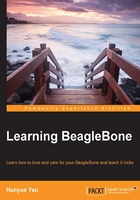
What this book covers
Chapter 1, Introducing the Beagle Boards, introduces you to the idea of the Beagle boards and also serves as a quick guide to the entire family of boards, as each board has unique features that may make one board more suitable than another. It goes on to unboxing your first BeagleBone and verifying whether it is running using a desktop or laptop system. It'll also take you through useful accessories for the BeagleBone.
Chapter 2, Software in the BeagleBone, introduces the software in the BeagleBone. It covers three aspects that include getting around the software that come with the board, getting precanned images onto the board, and building software for the board on the board. As part of this chapter, analogies to desktop software are provided.
Chapter 3, Building an LED Flasher, covers a basic introductory exercise of building a simple LED pattern flasher "product" using the LEDs on the BeagleBone, along with sample solutions. The entire example is doable with just the BeagleBone itself. The only other thing needed is a PC to interact with the board.
Chapter 4, Refining the LED Flasher, builds on the previous chapter and explains how to access the I2C bus. Again, no additional hardware is needed.
Chapter 5, Connecting the BeagleBone to Mobile Devices, looks at options to connect a BeagleBone to a mobile device, such as a phone using Bluetooth. It goes through different methods suitable for different types of mobile devices and the potential pitfalls of each method.
Chapter 6, Recovering from the Mistakes, covers possible mistakes that may cause the board to appear as dead. This chapter explains the process of attempting to recover from such mistakes. It also goes through a quick diagnostic process to determine whether the board is likely to be dead.
Chapter 7, Interfacing with the BeagleBone, takes you through the very basics of connecting simple hardware to the BeagleBone. It covers the basics of how to avoid damaging the board.
Chapter 8, Advanced Software Topics, covers more advanced ways of writing software for the BeagleBone. It provides guidance to help you go beyond what this book will cover.
Chapter 9, Expansion Boards and Options, explains what a cape is and the examples of off-the-shelf things that can be added. It also goes through the process of creating your own cape or even a basic expansion board.
Appendix A, The Boot Process, provides a slightly more detailed look at how a BeagleBone loads software while powering on. This is useful in finding rapid development methods or troubleshooting.
Appendix B, Terms and Definitions, provides background information on select terms used throughout the book for new BeagleBone users. These cover terms used both in this book and terms that may be encountered in the BeagleBone community.